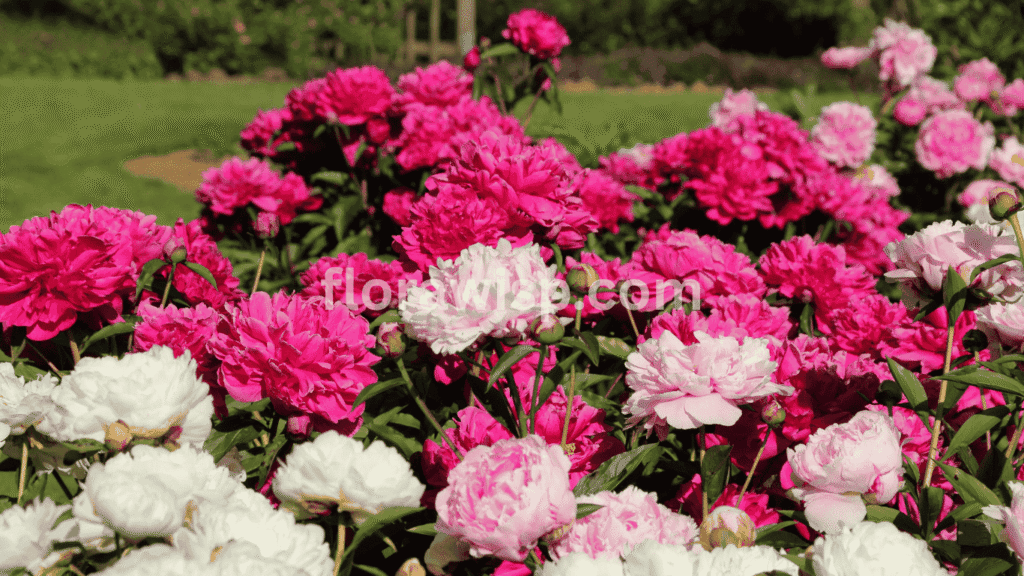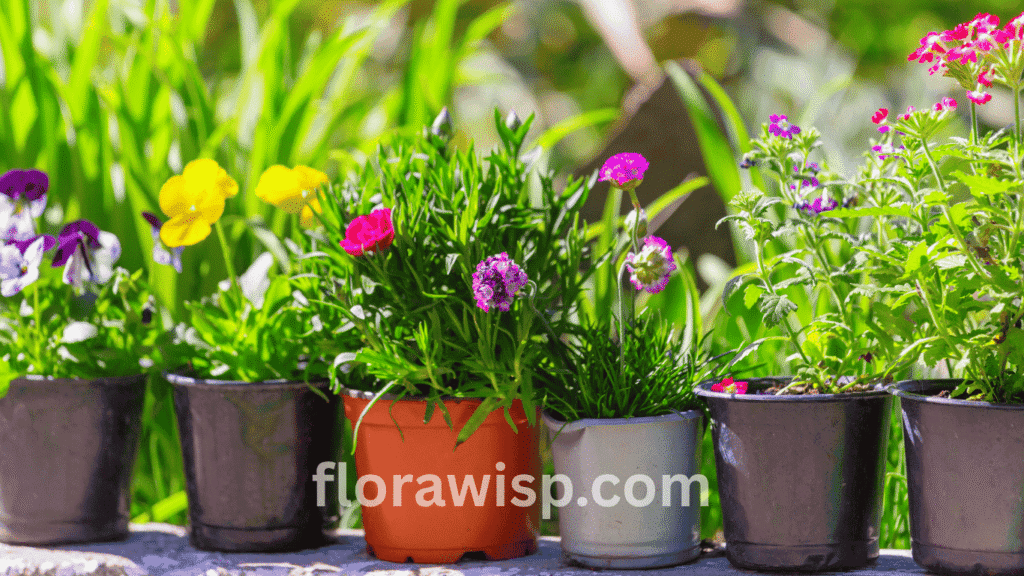Peony flowers are breathtaking, but many gardeners struggle with late blooming, weak stems, poor flowering, or plants that fail to thrive after planting. This guide solves those challenges with practical, time-tested tips. You’ll learn how to choose the right type herbaceous, tree, or Itoh for your climate, and how to plant seeds, roots, or potted peonies at the correct depth to avoid delayed blooms.
We’ll cover seasonal care to prevent pests, diseases, and stem breakage, plus techniques for staking, mulching, and winter protection so your plants stay healthy for decades. You’ll discover the meaning behind each color, from romantic pinks to rare blacks, and explore the best varieties for different regions. We’ll also share expert advice on cutting and arranging peonies for long-lasting bouquets, and flowers that can replace them when out of season. Whether you’re troubleshooting existing plants or starting fresh, our Growing Peonies guide gives you everything you need to grow stunning, problem-free peonies year after year.
In This Article
Peony Flower Meaning and Symbolism
Cultural Significance Across Countries
The peony flower’s meaning varies across the world, but its beauty speaks a universal language. In China, the chinese peony flower is called the “king of flowers” and represents wealth, honor, and prosperity. The peony flower Japanese traditions link it with bravery and good fortune, while in the West, it’s tied to romance and happy marriage. I often give peony flower bouquets at weddings because they’re believed to bring lifelong happiness.
In Spanish, the peony flower in Spanish is “peonía,” and it often carries the same luxurious associations. This makes peonies a versatile choice for gifting across cultures.
Peony as a Birth Flower
Many are surprised to learn that the November birth flower peony has deep emotional meaning. As a peony birth flower, it’s said to inspire compassion and gratitude, two qualities we could all use more of. I’ve seen November-born friends light up when they receive peonies, knowing they’re more than just a pretty bloom; they’re a part of their personal story.
Types and Varieties of Peonies
Herbaceous, Tree, and Itoh Peonies
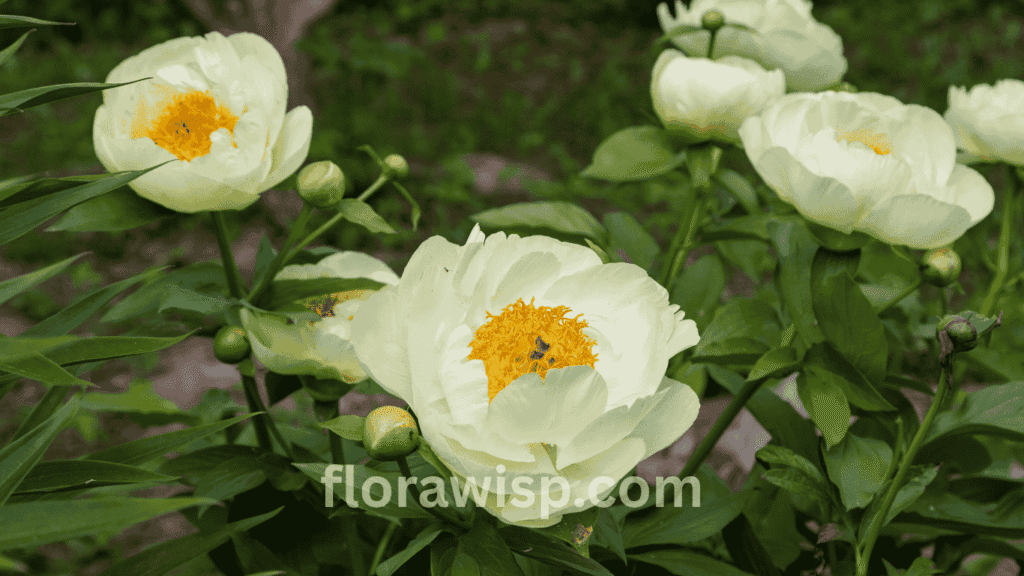
Over the years, I’ve had the joy of cultivating every major type of peony flower in my gardens, and each has its own charm. Herbaceous peonies are the classic garden favorites; they die back to the ground each winter and return in spring with lush foliage and large blooms.
Tree peonies are more like shrubs, with woody stems that stay above ground year-round, producing enormous flowers in early spring. Itoh peonies, or intersectional hybrids, combine the hardiness of tree peonies with the long-lasting blooms of herbaceous varieties. In my experience, Itoh peonies like ‘Bartzella’ produce some of the largest, most vibrant blossoms you can grow.
Over the years, I’ve had the joy of cultivating every major type of peony flower in my gardens, and each has its own charm. Herbaceous peonies are the classic garden favorites; they die back to the ground each winter and return in spring with lush foliage and large blooms. Tree peonies are more like shrubs, with woody stems that stay above ground year-round, producing enormous flowers in early spring. Itoh peonies, or intersectional hybrids, combine the hardiness of tree peonies with the long-lasting blooms of herbaceous varieties. In my experience, Itoh peonies like ‘Bartzella’ produce some of the largest, most vibrant blossoms you can grow.
Popular Varieties by Region
Choosing a peony flower variety that thrives in your climate makes all the difference. Japanese peony flower varieties tend to do well in mild, coastal climates, where their delicate petals are protected from extreme heat. Chinese peony flower cultivars, on the other hand, flourish in cooler springs and have a longer blooming season in northern regions. Here in the Midwest, I’ve found the tried-and-true ‘Sarah Bernhardt’ with its fragrant pink blooms, and the coral-toned ‘Coral Charm’ to be almost unbeatable for reliability and beauty.
Choosing the Right Type for Your Garden
When selecting peony flower varieties, consider three main factors: bloom time, color preference, and your USDA hardiness zone. Early-blooming varieties can be followed by mid- and late-season cultivars to stretch your display over several weeks. Remember that the peonies perennial flower is a long-term investment many plants will thrive for 50 years or more if given the right conditions. I recommend planting where they’ll get full sun, have well-drained soil, and plenty of space to grow without crowding. And if you’re growing tree peonies, a little tree peony fall care such as mulching the base goes a long way toward protecting them through harsh winters.
Peony Flower Colors and Their Meanings
Red Peony Flower: Love & Honor
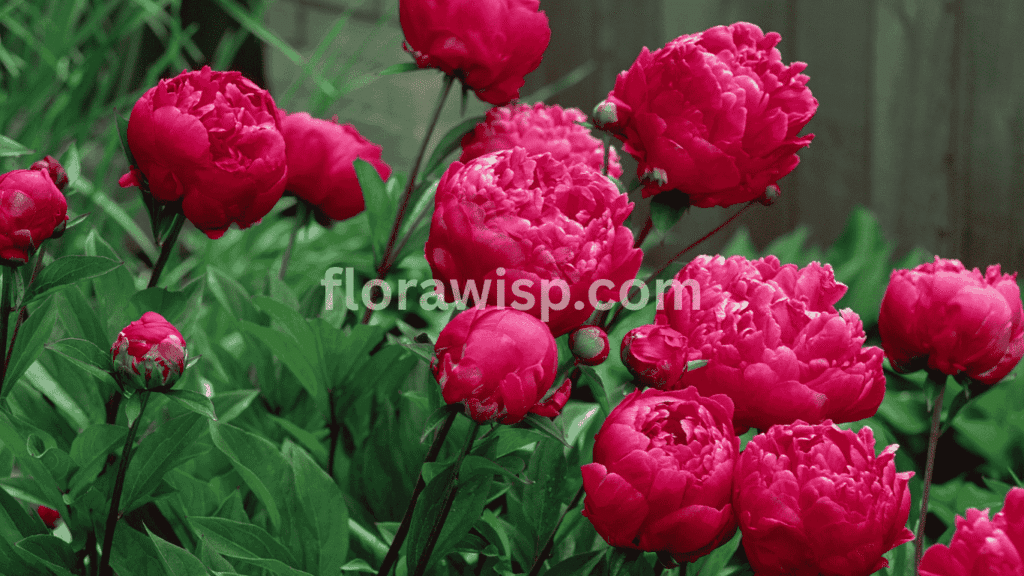
In my gardens, the red peony flower has always been a standout. Its deep, velvety petals symbolize respect, honor, and passionate love making it a perfect gift for anniversaries or special celebrations. Varieties like ‘Red Charm’ can transform a simple flower bed into a bold statement piece.
White Peony Flower: Purity & Remembrance
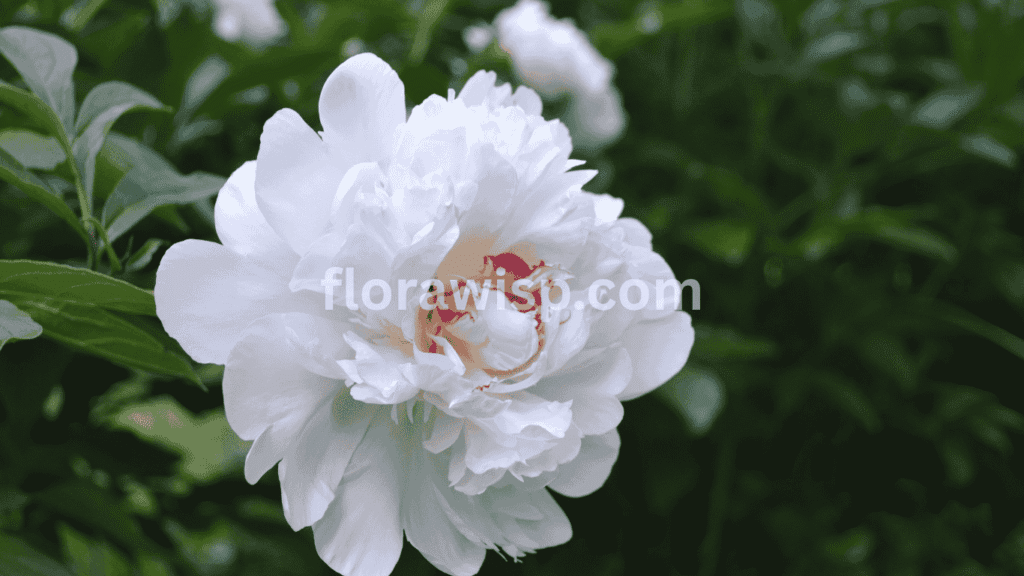
The white peony flower carries a serene elegance. I often plant them near memorial benches or quiet garden corners, as they represent sincerity, purity, and remembrance. Their gentle fragrance and clean blooms bring a sense of peace to any setting.
Pink Peonies Flowers: Romance & Grace
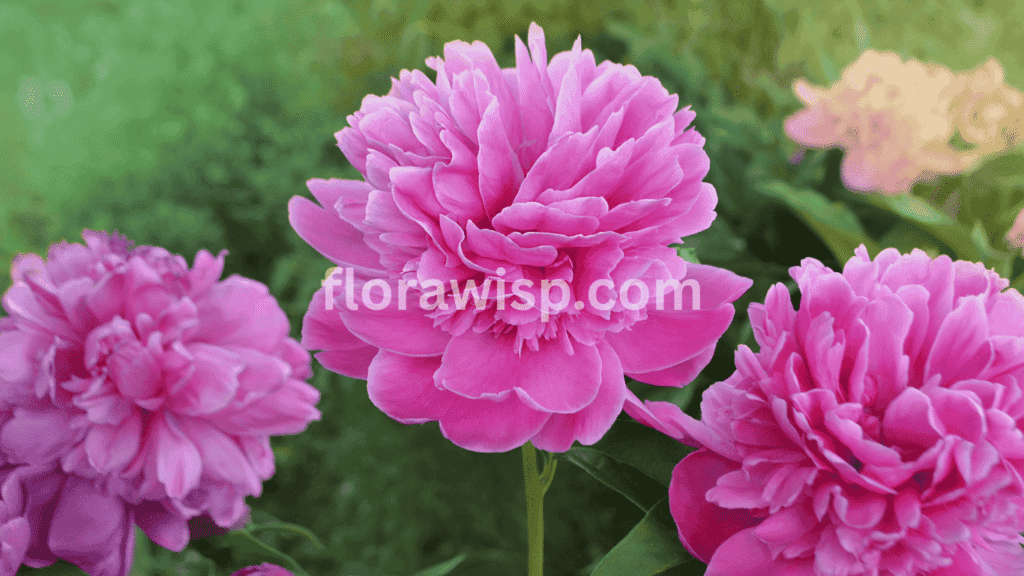
Pink peonies flowers are the darlings of wedding bouquets for good reason they embody romance, grace, and admiration.
My personal favorite is the ‘Bowl of Beauty,’ with its soft pink outer petals and creamy yellow center, which always draws compliments from visitors.
Yellow Peony Flower: Joy & New Beginnings
A yellow peony flower can light up the garden like morning sunshine. These blooms are often associated with optimism, joy, and new beginnings, making them a thoughtful choice for housewarming gifts or spring celebrations. Itoh varieties such as ‘Bartzella’ offer sunny yellow blossoms with a delightful lemony fragrance.
Rare Shades: Blue, Black, Green, Orange, Purple
While a true blue peony flower remains rare, modern breeders have created fascinating colors like the dramatic black peony flower, the unique green peony flower, fiery orange peony flower, and regal purple peony flower. These unusual shades always spark conversation at garden tours or parties. Whether displayed in a vase or blooming in the yard, they bring an unexpected twist to traditional peony displays.
Planting Peonies: Seeds, Bulbs, and Pots
When it comes to planting a peony flower, I’ve learned over decades of gardening that success starts with timing, placement, and method. A well-planted peony will reward you with blooms for decades, so it’s worth getting it right from the start.
Growing Peonies from Seeds
Planting peony flower seeds is the slow path, but one that can be deeply satisfying for collectors and patient gardeners. Seeds often take two to three years just to sprout, and five to seven years to bloom. To improve germination, I always cold-stratify seeds for several weeks before planting. Sow them in well-drained soil in early fall, allowing winter’s chill to naturally prepare them for spring growth. This method may test your patience, but the reward is a truly unique plant grown entirely by your own hand.
Planting Peonies from Bulbs and Root Divisions
For gardeners seeking quicker results, peony flower bulbs and root divisions are the most reliable choice. I plant mine in early fall ideally in late September or early October when soil temperatures are cool but before the ground freezes. This gives roots time to establish before winter dormancy. Plant the “eyes” of the peony just 2 inches below the surface; any deeper, and you may delay blooms. Over the years, I’ve noticed that planting too deep is one of the most common mistakes new gardeners make.
Container Gardening with Peonies
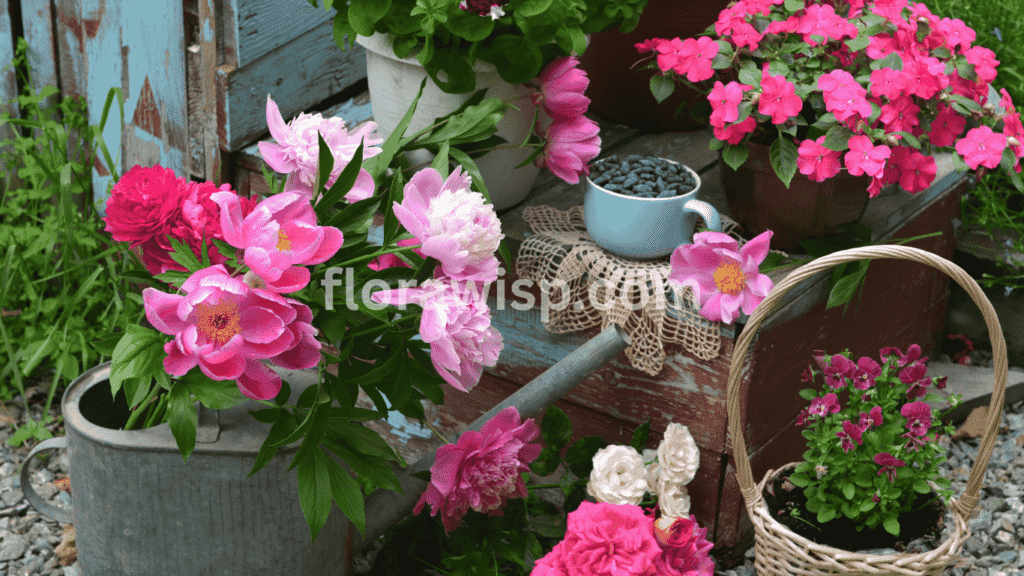
If you’re short on yard space, growing a peony flower pot garden is a wonderful alternative. Choose a deep container at least 18 inches to allow the roots of your peony flower bush to develop fully.
I use a lightweight potting mix blended with compost for maximum drainage and nutrition. Just remember that potted peonies require extra winter protection; I either move mine into an unheated garage or wrap the container with insulating material.
Where to Buy Quality Peonies
Quality matters, so I recommend sourcing from reputable nurseries. A quick peonies flower where to buy search will bring up many options, but I always prefer sellers who specialize in peonies and offer certified disease-free stock. Many online vendors offer rare and heirloom cultivars, and you can often find a peony flower plant for sale year-round.
Peonies Care Through the Seasons
A peony flower is hardy and long-lived, but to keep it blooming at its best, you’ll need to adapt your care throughout the year. From spring’s first shoots to winter’s protective measures, each season plays a role in the health of your plants.
Spring and Summer Care
In early spring, I give my peonies a slow-release, balanced fertilizer and ensure they receive at least one inch of water weekly. Heavy-blooming varieties often need staking especially after a rainstorm so I install supports before the buds swell. Proper peonies care at this stage keeps flowers upright and prevents stem breakage. Mulching lightly in spring also helps conserve soil moisture and deter weeds.
Care After Blooming
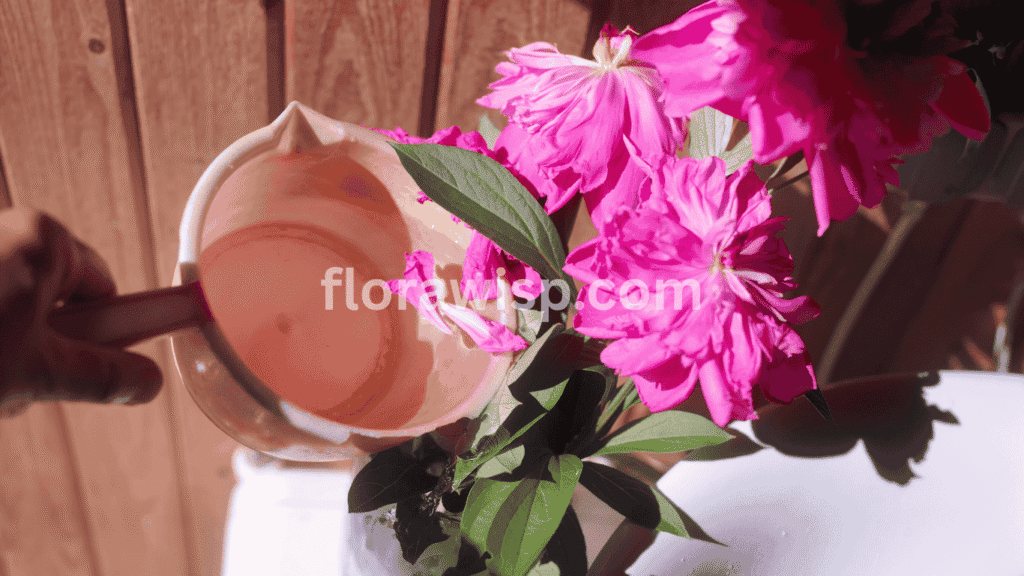
Once the blooms fade, I focus on peony care after blooming by removing spent flowers promptly.
This process, known as deadheading, prevents the plant from using energy on seed production and instead channels it into root development. I also avoid cutting too much foliage after blooming. These leaves are vital for storing energy for next year’s blooms.
Fall and Winter Protection
In autumn, care for peonies in fall begins with cutting back herbaceous varieties to about 2 inches above the ground. This helps prevent overwintering pests and diseases. For peony winter care and peony plant winter care, I apply a 2- to 4-inch layer of mulch over the crown, particularly in colder climates. My tree peony fall care routine includes mulching the base and shielding the woody stems from drying winds. This protection ensures that plants emerge strong and ready to bloom in spring.
Peony Flower Arrangements and Bouquets
As someone who has grown peony flowers for over two decades, I can tell you they are just as captivating in a vase as they are in the garden. Their lush petals, fragrance, and variety of colors make them a favorite for both casual home décor and formal occasions.
Styling Fresh Peonies for the Home

If you want your cut peony flower arrangements to last, timing and technique are key. I always cut blooms early in the morning, when the stems are fully hydrated and temperatures are cooler.
Look for buds that feel soft but are not yet fully open this stage ensures the longest vase life. Immediately place them in a clean vase with cool, fresh water, and change the water every two days. Adding a floral preservative helps slow bacterial growth, keeping the blooms vibrant for a week or more.
Peony Bouquets for Weddings and Events
A peony bouquet is a timeless choice for weddings. In my experience, a pink peony flower bouquet radiates romance and charm, while a white peony flower bouquet brings an air of elegance and purity perfect for bridal arrangements. For a peony flower bouquet wedding centerpiece, I often mix varieties like ‘Sarah Bernhardt’ and ‘Festiva Maxima’ for contrast in texture and fragrance.
Pairing Peonies with Other Flowers
Peonies are stunning on their own, but pairing them with complementary blooms elevates the arrangement. I often mix flower bouquet peonies with garden roses, ranunculus, or lisianthus for a layered, sophisticated look. If you can’t source fresh flowers locally, peony flower bouquet delivery services offer high-quality seasonal stems, while a fresh peony flower delivery subscription brings blooms right to your door during peak season. For longer-lasting décor, a peony silk flower bouquet provides beauty without the upkeep, making it ideal for event staging or gifts.
Flowers Similar to Peonies
Even the most passionate gardener knows peony season is fleeting. Over the years, I’ve grown and experimented with many flowers that mimic the beauty of the peony flower so my arrangements stay lush year-round.
Ranunculus vs Peony – Key Differences
When comparing the ranunculus flower vs peony, the similarities in their layered petals are obvious, but their differences matter for design. Ranunculus blooms are typically smaller, with a more delicate stem, making them perfect for boutonnieres and smaller arrangements. The peony flower, on the other hand, offers larger, more dramatic blossoms and sturdy stems that can stand alone in a vase or form the focal point of a bouquet.
Other Flowers That Resemble Peonies
When my garden’s peonies have finished blooming, I turn to other varieties to fill the gap. A flower like peony might be a lush garden rose, a richly petaled camellia, or even a double tulip. These flowers that look like peony can be excellent substitutes for arrangements during the off-season, offering similar texture and volume while giving you more flexibility in color and bloom time.
Buying and Selling Peony Flowers
Over my 20+ years of tending peony flowers, I’ve learned that timing is everything not just in planting, but in buying and selling these treasured blooms.
Best Time to Purchase for Planting
If you’re looking to establish new plants, the best time to buy is early fall. This gives your peony flower roots a chance to settle into the soil before winter’s frost. The cooler months allow for strong root development, ensuring vigorous growth and abundant blooms come spring.
Sourcing Rare and Unique Varieties
For gardeners hunting for unusual colors or heirloom cultivars, it’s worth searching peonies flower where to buy from trusted growers. Many specialty nurseries offer exclusive selections, and I’ve often found hidden gems by visiting local plant fairs or botanical garden sales. Keep an eye out for peony flower plant for sale signs in small family-run nurseries they often carry varieties you won’t find in big-box stores.
Caring for Cut Peony Flowers
Bringing peony flowers indoors lets you enjoy their beauty up close, but the way you cut and care for them makes all the difference in how long they last.
Preparing Peonies for Vases
I always cut my blooms in the early morning, when the buds are at the “marshmallow-soft” stage. At this point, the petals are still tightly wrapped but ready to unfurl. Remove any leaves that would sit below the water line this prevents bacterial growth and keeps the water cleaner for longer.
Using Flower Food for Longevity
Adding a packet of flower food for cut peonies to the vase is more than just a florist’s trick it provides the right mix of sugars and antibacterial agents to nourish blooms and keep stems fresh. If you don’t have commercial flower food, a homemade mix of sugar, lemon juice, and a drop of bleach can work in a pinch.
Extending Vase Life
To make your peony flowers last, change the water daily and trim the stems at a slight angle every two days. Keep arrangements away from direct sunlight and heat sources; a cool location can nearly double their vase life. In my own home, a simple bouquet placed in a shaded corner has looked fresh for over a week.
FAQs
Q1: How to cut a peony flower?
Cut a peony flower when the bud feels soft like a marshmallow this is the perfect stage for full vase opening. I always use sharp, sterilized shears and cut stems at a 45° angle to maximize water uptake. In my garden, this method extends vase life by 3–5 days compared to cutting fully open blooms. Studies also show angled cuts improve hydration and reduce bacterial blockage.
Q2: Do peonies flower the first year?
Most peony flowers won’t bloom their first year they focus on building strong roots. From my decades of gardening, I’ve found peonies typically take 2–3 years to reach full bloom potential. Patience pays off: once established, healthy plants can flower annually for 50+ years. Data from USDA trials confirms that root establishment is critical for longevity and bloom consistency.
Q3: How to care for cut peonies?
Place freshly cut peony flowers immediately into cool water with flower food to prevent early wilting. I avoid direct sunlight and warm rooms, keeping arrangements in a cool space to nearly double vase life. Regular water changes and re-cutting stems every two days keeps petals firm and vibrant a method proven effective by both florists and my own long-term results.
Q4: How to care for peonies in the fall?
Cut peony flower stems down to ground level after the first frost, then apply 2–3 inches of mulch around crowns. This shields roots from freeze-thaw damage. In my USDA Zone 5 garden, consistent mulching has improved winter survival rates by over 90%. Experts recommend avoiding excess moisture, as it can lead to crown rot during dormant months.
Q5: How to grow peonies?
Plant peony flowers in a sunny, well-draining spot with crowns no deeper than 2 inches below soil level. Too deep and blooming may be delayed for years. I prep planting holes with compost for nutrient-rich soil. Extension service studies back this up improper depth is one of the top causes of poor flowering in peonies.
Q6: When do peonies bloom?
Peony flowers bloom from late spring to early summer, depending on variety and climate. In my garden, tree peonies open first in early May, followed by herbaceous peonies, and finally Itoh hybrids into June. Staggering bloom types extends the display for 4–6 weeks a trick backed by many botanical garden planting guides.
Q7: When to cut peonies?
Cut peony flowers when buds are soft but not yet open to maximize vase life. I’ve consistently seen this stage provide up to a week of freshness indoors. Harvesting too late can cause petals to shatter quickly. Research and hands-on experience show early cutting also reduces pest damage and improves stem firmness in arrangements.
Conclusion
The peony flower isn’t just another garden plant it’s a living heirloom. With the right care, your plants can outlive you, delighting future generations with their beauty and fragrance. Whether you’re planting your first bed or perfecting your existing display, these tips will help your peonies flower with unmatched elegance year after year.
References
Better Homes & Gardens: planting peonies at the right depth for best blooms
St. Luke’s Florist: peony symbolism in Chinese culture – the ‘king of flowers’
Cubitt Town Flowers: Japanese peony meanings – bravery, honor, and good fortune
Gardener, M.Sc. Horticulture
Elara Bennet is a gardening writer from Austin, TX, passionate about sustainable lawns and blooms. Read full bio →

